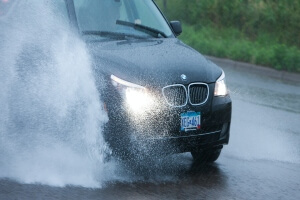Who May Be Liable if Hydroplaning Leads to a Minnesota Car Crash?
 Minnesota winters are harsh, often resulting in hazardous driving conditions, including those resulting from heavy rains or melting snow. Drivers who do not adjust to the changing weather may lose control of their vehicles and hydroplane. If you are injured in a hydroplaning car crash, it is important to understand who may be liable for your medical costs and other damages.
Minnesota winters are harsh, often resulting in hazardous driving conditions, including those resulting from heavy rains or melting snow. Drivers who do not adjust to the changing weather may lose control of their vehicles and hydroplane. If you are injured in a hydroplaning car crash, it is important to understand who may be liable for your medical costs and other damages.
If you were injured in a hydroplaning collision, we encourage you to contact a lawyer as soon as possible. At TSR Injury Law, our experienced Minneapolis car crash lawyers have decades of experience managing crash claims for injured victims, and we have a proven history of success. We fight hard to get you the results you deserve.
Find out how we can help you. Call: (612)-TSR-TIME today for a FREE case review.
What Is Hydroplaning?
Hydroplaning happens when water forces your vehicle’s tires to lose contact with the road surface. This loss of traction happens when there is more water than your tires are capable of moving out of the way. This condition can cause vehicles to slide or skid, making steering difficult or impossible.
Who May Be Liable for a Hydroplaning Collision in Minneapolis?
While weather plays a significant role, the hydroplaning driver is often liable if a crash occurs. However, liability cannot be assumed, and there are several factors that must be considered. Under Minnesota law, multiple parties could be liable, or at least partially liable, for a crash resulting from hydroplaning, including:
The Hydroplaning Driver
Most hydroplaning crashes involve some degree of driver responsibility. Common driver-related factors include:
- Driving too fast for wet conditions
- Failing to maintain tires
- Ignoring visible road hazards
- Following other vehicles too closely
- Making sudden movements that reduce traction
- Operating a vehicle with faulty wipers or headlights
- Driving with underinflated or overinflated tires
Minnesota law requires drivers to adjust their speed and driving behavior to match road conditions. Failure to do so might constitute negligence, making the driver liable for any resulting damages.
Other Drivers
Multiple vehicles often become involved in hydroplaning crashes. Contributing factors from other drivers include:
- Sudden braking causing following vehicles to lose control
- Unsafe passing in wet conditions
- Creating excessive spray that reduces visibility
- Failing to maintain proper following distance
- Making abrupt lane changes
- Driving without required lighting
- Operating vehicles with obvious safety defects
Government Entities
State and local governments must maintain safe roadways. They might bear liability when poor road design or maintenance contributes to hydroplaning crashes. Contributing factors include:
- Inadequate drainage systems
- Poor road grading
- Lack of proper warning signs
- Failure to address known flooding issues
- Delayed repair of damaged road surfaces
- Insufficient roadway texture
- Improper crown design causing water pooling
Tire Manufacturers and Retailers
Tire-related issues frequently contribute to hydroplaning crashes. Responsible parties might include:
- Tire manufacturers for design flaws, such as treads that are too shallow, affecting water displacement
- Service centers improperly installing or maintaining tires
- Distributors failing to store tires properly
- Shops performing inadequate tire inspections
- Businesses selling expired tires
- Retailers misrepresenting tire capabilities
Construction Companies
Road construction activities sometimes create conditions that increase hydroplaning risks:
- Improper water diversion during projects
- Failing to post adequate warning signs
- Creating unsafe elevation changes
- Leaving loose gravel or debris
- Poor temporary drainage solutions
- Inadequate surface preparation
- Improper grading of construction zone
How Is Liability for a Hydroplaning Crash Determined in Minnesota?
Under Minnesota Law, the chain of events leading up to the crash will be examined, as well as the role each driver played in the resulting hydroplaning crash. Multiple factors will be considered, including:
- Driver behavior and speed prior to the crash
- The condition of the hydroplaning vehicle’s tires
- Road conditions
- Actions of other drivers involved
- Police reports
- Physical evidence from the crash scene
- Credible witness statements
- Vehicle damage
- Expert opinion of a collision reconstruction specialist
What if I Am Partially To Blame for a Hydroplaning Crash?
Minnesota lets you recover damages as long as you are less than 51 percent at fault. Your compensation drops by the amount of your fault percentage. If you are 30 percent at fault for a crash resulting in $100,000 in damages, your awarded compensation is $70,000. Multiple liable parties pay their share based on fault level.
Steps You Can Take To Avoid a Hydroplaning Crash
Driving defensively can help you avoid a hydroplaning car crash, such as by:
- Maintaining proper tire pressure
- Replacing worn tires promptly
- Slowing down in wet conditions
- Increasing your vehicle’s following distance
- Avoiding swerves, braking or other sudden vehicle movements
- Remaining alert for standing water when driving
- Checking weather forecasts
- Maintaining windshield wipers
Need Legal Help After a Car Crash? Contact Our Trusted Law Firm in Minneapolis
Complex liability issues in hydroplaning crashes often require experienced legal representation. Our highly qualified legal team at TSR Injury Law advocates for injured victims every day, including those hurt in car crashes.
Contact our law firm to discuss your situation and learn about your potential legal options. There is no cost or risk for this meeting. When we represent you, there are also no upfront costs or fees to pay. We only get paid if you do. We fight to get you the full and fair compensation you deserve.
Call TSR Injury Law to get the results you need. (612)-TSR-TIME.



